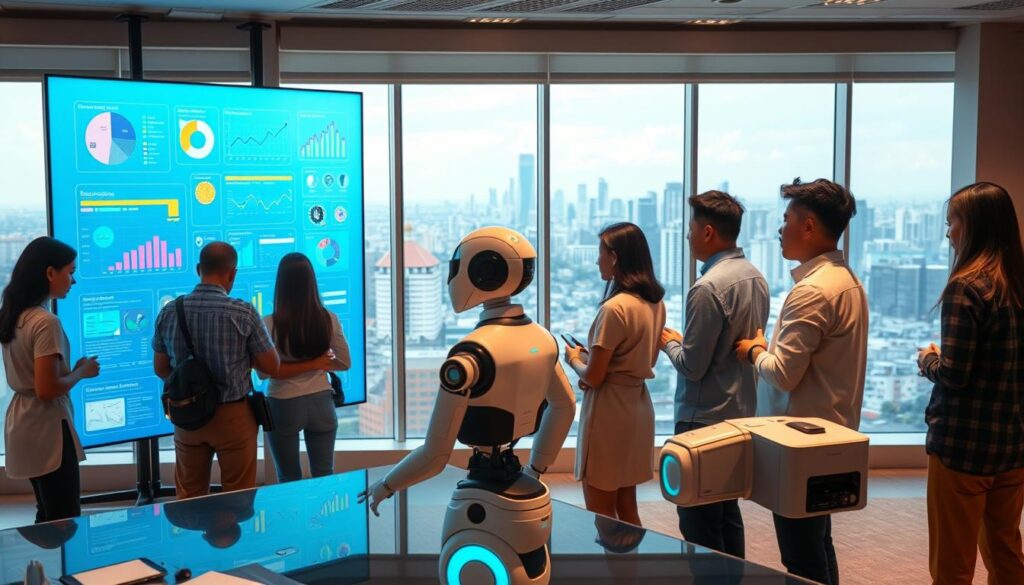Are you ready for a technological shift that could change your business forever? Hyper-automation with AI is coming, and it will change how we work. By 2025, automation trends will make old ways of working seem outdated.
Business leaders must understand how AI and advanced automation work together. This knowledge is key to staying ahead. Companies that adopt hyper-automation could cut costs by 30% by 2024. This change will shake up the business world.
This new technology will make things more efficient and change how we make decisions. It will also change how we use resources and carry out tasks.
In the Philippines and Southeast Asia, businesses must get ready for this change. They can use machine learning and no-code platforms to make things better. This will help them work smarter and prepare for a future where humans and AI work together.
Hyper-automation will make things more productive and create new jobs. These jobs will need people who can think creatively and solve problems.
Key Takeaways
- Hyper-automation is expected to become a necessity for businesses by 2025, enabling greater efficiency and cost reduction.
- AI will facilitate real-time data analytics, leading to quicker, informed decision-making.
- No-code and low-code platforms will democratize automation, allowing broader employee participation.
- Machine learning will continuously refine business processes by leveraging both historical and real-time data.
- AI-driven technologies will enhance customer interaction and internal efficiencies across industries.
- Future job roles will demand critical thinking and problem-solving abilities rather than being replaced by automation.
Understanding Hyper-Automation and Its Importance for Business Leaders
Businesses are changing fast, and leaders need to understand hyper-automation. It combines different automation technologies to make processes better. Hyper-automation boosts efficiency, cuts costs, and makes operations smoother.
What is Hyper-Automation?
Hyper-automation uses advanced tech like AI, RPA, and process orchestration to automate many business tasks. It aims for wide-scale automation to boost productivity and speed up work. Studies show it can make processes 30% faster, proving its worth.
The Role of AI in Hyper-Automation
AI is key in hyper-automation, driving innovation and efficiency. It makes business functions smarter by handling data and workflows better. For instance, Mercy Radiology saw a big improvement in cash flow by automating invoices, reaching 98% automation.
AI in hyper-automation also lets digital workers work together, helping businesses grow and meet customer needs. Hyper-automation is a game-changer for businesses, keeping them ahead while making operations better. It’s great for tackling complex rules and improving customer happiness.
Key Trends in Automation for 2025
The world of automation is changing fast as companies look to 2025. New trends are coming that will change how businesses work. These trends bring in new tech and ways to work smarter and make better choices.
The Growth of AI Integration
By 2025, AI will be key in making businesses run better. It will change about 20% of business processes. This means companies can use AI to make things better in healthcare and finance.
As AI gets better, businesses will work more efficiently. They’ll make smarter choices because AI handles the routine tasks.
Rise of Low-Code Solutions
Low-code platforms are becoming more popular. They let people who aren’t tech experts help with automation. This makes businesses more agile and able to automate more without needing IT.
Small and medium businesses will gain a lot from this. It will help them use automation more, making it a big trend for 2025.
Enhanced Analytics and Decision Making
Analytics will play a big role in making decisions based on data. Companies will use real-time data to improve how they work. This balance between tech and human touch will help them stay flexible.
Keeping data safe will also be crucial. As companies use more analytics, they need to protect their systems from threats.

How Asian Companies Are Leading in Hyper-Automation
Asian companies are leading in hyper-automation. They use the latest technology to improve services and work efficiency. By adopting industry 4.0 solutions, they change old ways of working to meet today’s needs.
Case Study: Grab’s Automation Strategies
Grab is a top tech company in Southeast Asia. It uses advanced tech to make its ride-hailing, food delivery, and financial services better. AI chatbots and RPA help Grab answer customer questions fast and change plans based on what people need.
This has made using Grab services better and more flexible for everyone.
Case Study: Gojek and Efficiency
Gojek is a great example of how to automate logistics and driver scheduling. It uses smart algorithms to cut down wait times for customers and boost service quality. Gojek’s focus on hyper-automation shows how to be efficient in competitive markets where quick action is key.
Benefits of Implementing Hyper-Automation
Hyper-automation brings more than just speed to businesses. It uses advanced tech to make processes smoother. This leads to better productivity and cost control. It’s a game-changer for the future of AI in business.
Increased Efficiency and Productivity
Hyper-automation makes tasks faster, saving time and effort. It lets workers focus on creative tasks. For example, in healthcare, it streamlines patient records and schedules.
In finance, it handles transactions quickly, cutting down processing time by up to 60% in e-commerce.
Cost Reduction and Resource Management
Hyper-automation cuts costs in many fields. It’s expected to lower operational costs by 30% by 2024. In finance, it can slash costs by up to 70% in tasks like invoice processing.
It also reduces errors and repetitive tasks. For example, in manufacturing, it automates quality checks. This ensures products meet high standards and cuts down on human mistakes.
| Industry | Application | Results |
|---|---|---|
| Healthcare | Automated scheduling and administrative tasks | Saved 1,200 work hours annually |
| Finance | Payment transaction verification | Flagged 90% of fraudulent transactions |
| Logistics | Route optimization and shipment tracking | Reduced delivery delays significantly |
| Retail | Real-time personalization and order fulfillment | Increased conversion rates by 25% |

The Challenges of Adopting AI-Powered Automation
The rise of AI-powered automation offers many benefits. Yet, businesses face big challenges when adopting it. It’s key to understand these hurdles for a smooth transition to automated operations.
Workforce Adaptation and Training
About 70% of organizations feel unready for AI adoption. A big issue is the lack of skilled workers, affecting 60% of companies. This shows a big need for training programs to help employees adjust to new roles.
Resistance from employees also hinders AI adoption, with 30% of firms facing pushback. A good change management strategy can help. It ensures a better fit between human resources and AI capabilities.
Data Security and Privacy Concerns
Data security is crucial in AI automation. Companies must deal with complex regulations, with 20% worried about compliance. As automation grows, so does the risk of data breaches, affecting 45% of businesses.
Organizations must focus on strong security measures. This protects sensitive data and meets changing regulations. Ensuring AI is used ethically and securely is vital.
As AI adoption evolves, tackling these challenges is essential. It allows businesses to fully benefit from automation while creating a secure and adaptable work environment.
AI-Powered Hyper-Automation Tools for Businesses
Businesses are now using special tools to make their operations more efficient. These tools include robotic process automation (RPA) and business process management (BPM) solutions. They help improve workflow management and increase productivity.
Robotic Process Automation (RPA)
Robotic process automation helps businesses automate tasks that need rules. It cuts down on manual work in tasks like data entry and invoice processing. This way, companies can quickly see benefits and use their people for more important tasks.
RPA tools are getting easier to use. This means more people can start using them, speeding up automation in different fields.
Business Process Management (BPM) Solutions
Business process management solutions help manage and improve workflows. These tools let companies model, analyze, and adjust their processes. They give valuable insights into how well things are working.
By using BPM solutions, companies can stay flexible and meet changing market needs. Combining BPM with RPA creates a highly automated system. This boosts efficiency from the start to the end of sales.

Best Practices for Implementing Hyper-Automation
Hyper-automation needs careful planning. Using the best practices helps manage automation tools better. A good plan starts with small steps, so businesses can track their progress and adjust as needed.
Starting Small with Pilot Projects
Starting with small pilot projects is a smart move. It lets organizations try out different automation tools without stressing teams too much. This way, they can learn from the start and make changes for better results.
Feedback from these early projects helps improve and adjust. It makes it easier to grow successful practices across the company. Learning from these projects also helps find the best tools and methods for the future.
Engaging Stakeholders Across the Organization
Getting everyone involved is key. It helps everyone work together and meet different needs and concerns. Talking openly about automation helps get everyone on board and makes it easier to adopt.
Working together with automation plans is important. It helps find new ways to innovate and ensures automation sticks around. This teamwork makes the organization stronger and more flexible as automation changes.
Future Skills Needed for the Workforce
The world is changing fast, thanks to AI and automation. We need certain skills in the future workforce. Digital literacy and continuous learning are key. They help employees face new challenges and stay ahead in the job market.
Emphasis on Digital Literacy
Digital literacy is now a must for most jobs. People need to know how to use new tools and platforms. This skill helps them work better and connect with customers easily.
Companies should focus on improving digital literacy. This way, they can stay competitive.
Importance of Continuous Learning
Continuous learning is vital for success in the future. Automation will take over simple tasks, leaving us with more complex ones. Companies need to support learning and growth.

| Skill Type | Description | Impact on Workforce |
|---|---|---|
| Digital Literacy | Understanding and using new digital tools | Enhances productivity and innovation |
| Continuous Learning | Ongoing skill development and adaptability | Prepares workforce for evolving demands |
| AI Proficiency | Knowledge of AI tools and their applications | Increases efficiency and competitive edge |
| Data Analysis | Ability to interpret and utilize data | Supports informed decision-making |
Investing in digital literacy and continuous learning is key. It helps companies use their workforce to the fullest. This way, they can stay strong as technology keeps changing.
Measuring Success in Hyper-Automation Initiatives
To get the most from hyper-automation, businesses need to measure success well. They must pick the right key performance indicators (KPIs for automation). These help show how well automation meets business goals.
Key Performance Indicators (KPIs) to Consider
When checking on hyper-automation, look at these KPIs:
- Process efficiency: See how much time is saved. Hyperautomation can cut processing times by up to 50% in claims.
- Error rates: Watch how many mistakes automated systems make. Automation aims to cut down errors, boosting financial health.
- Cost savings: Keep an eye on lower labor and operational costs. Hyper-automation can lead to big savings.
- Employee satisfaction: Check how automation lets staff do more strategic work. This can make them more productive and happy.
Feedback Loops for Continuous Improvement
Feedback loops help improve automation by constantly checking processes. This way, businesses can quickly adjust to new needs and improve their automation. For example, companies can use hyper-automation to scale successful products based on real-time demand.
By setting strong KPIs and using feedback loops, companies can stay ahead in hyper-automation. This approach helps them keep improving, making their automation work better.
Preparing Your Business for the Future of Automation
To move forward in hyper-automation, businesses need a clear roadmap for implementation. This plan should include strategic goals, resources needed, and a timeline for AI adoption. By planning ahead, companies can tackle the challenges of new tech, boosting efficiency and staying competitive.
Creating a Roadmap for Implementation
Starting on the AI automation path requires careful planning. Businesses should first identify tasks that can be automated. This frees up time for more important tasks. Setting up KPIs helps measure success, making sure new systems meet business goals and improve agility.
Building a Culture of Innovation and Technology Adoption
Creating a culture of innovation is key, not just the tech. Companies should foster teamwork between tech and operations. This helps employees feel ready to use automated systems every day.
Training and skill-building are essential. They help employees use AI to its fullest, improving customer service and business performance. Also, focusing on AI ethics builds trust within teams and with customers. This is crucial for a sustainable future in automation.

